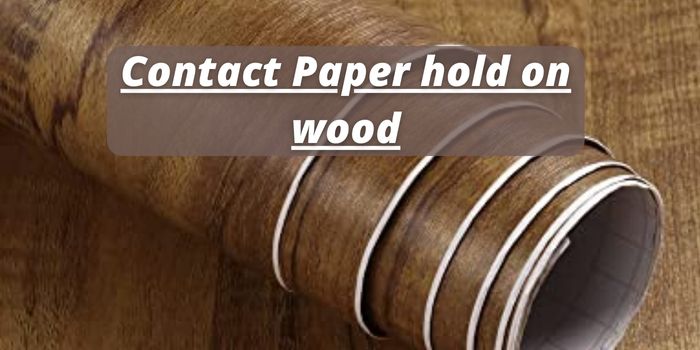Picture this: you’re staring at your drab, tired-looking floor, yearning for a quick and affordable makeover. You’ve heard about contact paper, that magical adhesive that can transform furniture, shelves, and even walls. But can you use contact paper on the floor? This question pops into your head, full of excitement and a hint of hesitation. The thought of a stylish, budget-friendly floor update using contact paper is tempting, but can it handle the wear and tear of foot traffic?

Image: woodthrive.com
This article will dive deep into the world of contact paper and flooring, exploring its potential and its limitations. We’ll uncover the truth behind using contact paper on your floor, offering you the knowledge to make an informed decision and get the stylish floor you desire.
The Allure of Contact Paper for Flooring
There’s a certain charm to contact paper. It’s versatile, easy to apply, and often available in a wide range of colors and patterns. The prospect of transforming dull floors into eye-catching features without breaking the bank is undeniably attractive. Imagine adding a wood-look finish to your kitchen floor for a fraction of the cost of real hardwood. Or maybe you’re dreaming of a patterned, whimsical tile look in your bathroom. Contact paper seems to offer endless possibilities.
However, before rushing to the craft store and stocking up on contact paper rolls, it’s essential to consider the unique challenges and realities of using it on your floor.
Contact Paper on the Floor: The Good, the Bad, and the Ugly
The truth is, using contact paper on your floor is a delicate dance of possibilities and limitations. Let’s break down the pros and cons to understand if this DIY project is right for your home:
The Good:
-
Affordability: This is undoubtedly the biggest advantage. Contact paper is significantly cheaper than traditional flooring options, offering an attractive budget-friendly solution.
-
Easy Installation: Most contact paper rolls come with a grid pattern, making precise cutting and placement a breeze. Many tutorials and videos online can guide your installation process, making it a project even a novice DIYer can handle.
-
Aesthetic Versatility: Contact paper’s range of patterns, colors, and textures can help you achieve countless floor styles, from the sleek and modern to the rustic and whimsical.
The Bad:
-
Durability: Contact paper is inherently thin and sensitive to wear and tear. The constant friction of foot traffic can lead to tears, scratches, and peeling, especially in high-traffic areas.
-
Moisture Sensitivity: Most contact paper types are not waterproof or even water-resistant. Spills or even high humidity can damage the adhesive and cause the paper to warp or detach.
-
Limited Lifespan: Contact paper is, at its core, a temporary flooring solution. You’ll likely need to replace it more frequently compared to traditional flooring materials.
The Ugly:
-
Potential for Staining: Spills and dirt can seep into the porous surface of contact paper, making cleaning difficult and potentially leading to permanent stains.
-
Slipperiness: Some contact paper finishes, especially those with glossy or smooth surfaces, can become slippery when wet, posing a safety hazard.
Finding a Happy Medium: When Contact Paper Might Work
Despite its limitations, contact paper can be a viable flooring solution in specific scenarios.
-
High-Traffic Areas, Not So Much: Avoid using contact paper in areas that experience heavy footsteps or furniture movement, such as entryways, living rooms, or kitchens. It simply won’t withstand the constant wear and tear.
-
Low-Traffic Areas, Consider It: Use contact paper in areas with limited foot traffic, such as closets, pantries, under furniture, or even small bathroom areas.
-
Temporary Solutions: Contact paper is excellent for short-term projects, such as creating a visually appealing backdrop for events, covering floors during renovations, or adding a temporary pop of color to a rental space.
-
Layering: Use contact paper as a base layer for a more robust flooring solution. For instance, you could apply a layer of contact paper over existing tiles or linoleum to refresh the look and then add a rug or a floor mat on top for added protection.
-
Specific Contact Paper Types: Look for contact paper designed for tough applications, such as those marketed as “heavy-duty,” “water-resistant,” or “commercial-grade.” These types may offer better durability and resistance to wear and tear.

Image: www.rocktherm.com
Expert Tips for Successful Contact Paper Flooring
Before diving into a contact paper floor project, consider these wise insights from experts:
-
Invest in Quality Contact Paper: While cheaper contact paper might be tempting, choosing a higher-quality brand with a stronger adhesive and thicker material can significantly extend its lifespan and durability.
-
Clean Your Floor Thoroughly: A clean, smooth surface is crucial for contact paper adhesion. Ensure your existing floor is free of debris, dust, and old adhesive residue before applying contact paper.
-
Apply with Precision: Take your time and ensure the contact paper is applied evenly and without air bubbles. Use a squeegee or roller to smooth out any creases or wrinkles.
-
Consider Protective Coatings: Investing in a clear sealant or a water-resistant finish can help prolong the life of your contact paper floor by adding a layer of protection against spills, grime, and everyday wear and tear.
Can You Use Contact Paper On The Floor
In Conclusion: Contact Paper for Flooring – A Calculated Risk?
Ultimately, using contact paper on your floor is a decision that requires careful consideration. While it offers a budget-friendly and visually appealing solution, its durability and lifespan limitations must be factored in.
For low-traffic areas or temporary projects, contact paper can be a great option. But in high-traffic areas or for long-term solutions, you might want to explore more durable flooring alternatives.
Don’t hesitate to share your experiences with contact paper flooring in the comments below! Perhaps you’ve found a clever trick or have some exciting DIY success stories to share. Let’s inspire and learn from each other.






